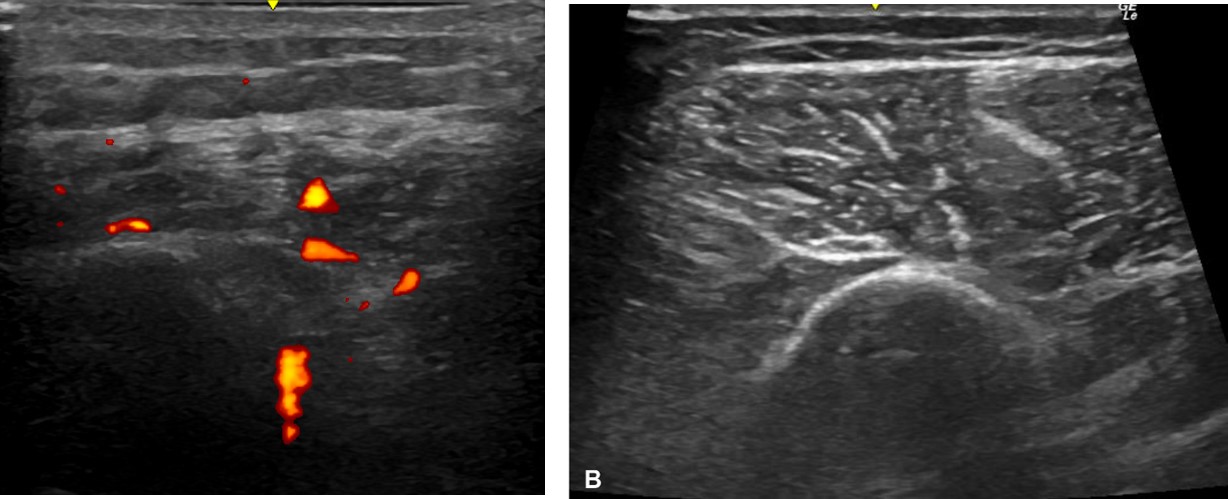Session Information
Date: Monday, November 18, 2024
Title: Muscle Biology, Myositis & Myopathies – Basic & Clinical Science Poster III
Session Type: Poster Session C
Session Time: 10:30AM-12:30PM
Background/Purpose: Muscle ultrasound (MUS) is a non-invasive tool that may explore the extent of muscle abnormalities and contribute to early diagnosis and follow-up of patients with Idiopathic inflammatory myopathies (IIM). This study aims to compare the ultrasonographic findings with the clinical features of disease activity of patients with IIM.
Methods: Cross-sectional study that included patients older than 18 with IIM according to the 2017 ACR/EULAR classification criteria. We evaluated the patients according to the core set measures of the International Myositis Assessment and Clinical Studies (IMACS) group. According to the clinical and laboratory evaluation (muscle weakness, decrease in MMT8 score, and elevation of creatine kinase), the patients were divided into active and inactive patients. The MUS was performed using a GE LOGIQTMe machine with a 4-12 MHz linear probe. Ten muscles were evaluated bilaterally: sternocleidomastoid, deltoid, biceps brachii, extensor carpi radialis longus, quadriceps femoris, tibialis anterior, gastrocnemius, gluteus minimus, medius, and maximus. The Siena Myositis Ultrasound Grading Scale (SMUGS) was used to evaluate muscle edema, echo-intensity changes, muscle atrophy, and power Doppler signal (PD). The sonographer was blinded to clinical and laboratory data. Descriptive analyses were performed, and we determined the sensitivity and specificity of MUS to diagnose muscle disease activity; a p-value of ≤0.05 was considered statistically significant.
Results: Eighty-seven patients were recruited. Most patients were women (71.3%). The median (interquartile range, IQR) age was 49 (33-57). The most frequent diagnosis was dermatomyositis, presented in 67 patients (77%), followed by anti-synthetase syndrome in 12 patients (13.8%), polymyositis in 2 (2.3%), and overlap myositis in 6 (6.9%). Forty-five patients (51.7%) had active myositis. Muscle edema in sternocleidomastoid, gastrocnemius, biceps brachii, and extensor carpi radialis longus were associated with muscle activity (p< 0.05). The presence of edema defined by MUS as hypoechoic areas with septa diffusely less evident in 3 individual muscle groups to identify disease activity has a sensitivity of 87% and specificity of 80%, with an area under the curve of 0.83 (0.74-0.92).
Conclusion: The MUS, as demonstrated, allows the identification of patients with clinically active disease. This makes it a potential screening tool for suspected activity in patients with IIM, aiding in their timely and effective management.
To cite this abstract in AMA style:
Soto-Fajardo C, Espinosa-Orantes A, Enríquez-Luna A, Carranza Enriquez F, Cano-Gamez T, Mora-Rosas A, Cervantes-Ramirez R, Contreras-Castillo K, Torres Ruiz J, Gómez-Martin D, Pineda C. Ultrasound Findings of Activity in Patients with Inflammatory Myopathies and Clinical and Laboratory Comparison [abstract]. Arthritis Rheumatol. 2024; 76 (suppl 9). https://acrabstracts.org/abstract/ultrasound-findings-of-activity-in-patients-with-inflammatory-myopathies-and-clinical-and-laboratory-comparison/. Accessed .« Back to ACR Convergence 2024
ACR Meeting Abstracts - https://acrabstracts.org/abstract/ultrasound-findings-of-activity-in-patients-with-inflammatory-myopathies-and-clinical-and-laboratory-comparison/

